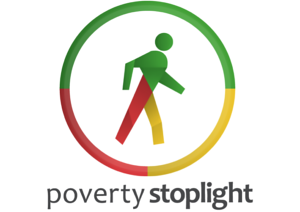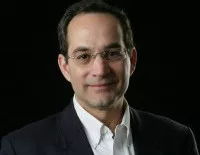Martin Burt represented Poverty Stoplight at the SOCAP 365 event “Welcome Party: Poverty Stoplight comes to Washington, D.C.” on Friday, February 10. We were able to talk with Martin prior to the event.
 Poverty Stoplight is working to eliminate poverty, household by household, in countries around the world. They do that by talking directly to people who are living in poverty conditions. They’ve developed a measurement tool and a methodology that helps impoverished families map their needs so they can navigate a way out. Since its inception in 2011, Poverty Stoplight has helped thousands upon thousands of families lift themselves out of poverty globally, from Paraguay, where the program started, to 25 countries including South Africa, Taiwan, Ecuador, UK, Tanzania, Nigeria and the U.S. (in New Orleans, Louisiana).
Poverty Stoplight is working to eliminate poverty, household by household, in countries around the world. They do that by talking directly to people who are living in poverty conditions. They’ve developed a measurement tool and a methodology that helps impoverished families map their needs so they can navigate a way out. Since its inception in 2011, Poverty Stoplight has helped thousands upon thousands of families lift themselves out of poverty globally, from Paraguay, where the program started, to 25 countries including South Africa, Taiwan, Ecuador, UK, Tanzania, Nigeria and the U.S. (in New Orleans, Louisiana).
We talked to Martin Burt, founder of Poverty Stoplight and the NGO Fundación Paraguaya about his innovative “bottom up” approach to ending poverty around the world.
SOCAP: How does the Poverty Stoplight approach to eliminating poverty differ from other organizations with the same goal?
Martin Burt: Poverty is multidimensional. By looking at poverty beyond income you can find many additional solutions. Poverty Stoplight is a new measurement tool that helps people self diagnose their level of poverty, across 50 indicators. That is 50% of the work. Poverty Stoplight also allows people to convert that diagnosis into a family action plan. The unit of analysis is not the individual, but rather the household. So you have a bottom up approach to self diagnosis (that involves) taking stock of what you are good at and what you are lacking. It is a self awareness approach that is quite empowering.
The difference between Poverty Stoplight and other approaches that are out there is that it is not a poverty index, but a dashboard. It is not an aggregation of data, but a disaggregation. The information can be aggregated to analyze the data, but the prime decision maker here is not the head of a welfare agency, but the head of the household. What you have here is a survey that is not extractive. It is not that somebody goes to the house and sucks the information away, the person is doing her own survey–compiling data for herself and developing a dashboard that can help her prioritize her actions.
Can you give an example of how the measurement process works at the household level?
The head of a household, either at home or in the workplace, fills out the survey using a computer or tablet. At the end of that 20 minute visual survey you get your own dashboard which gives you an idea of where you are in everything: weight, income, housing, transportation, violence, self esteem, family budget, financial health…etc. The dashboard shows each indicator as red (extreme poverty), yellow (poverty) or green (not poverty) for the entire household. If the adult has a child, the adult cannot overcome poverty without the child being well taken care of and vice versa. You cannot get a child out of poverty if the mother is chronically unemployed.
Your solution is also described as a coaching methodology. Does a mentor work with the head of household to develop their plan to get out of poverty?
Yes. Once the person sees their dashboard, then the program facilitator, who could be a social worker or the head of HR in the company, helps them to identify the top three priorities they want to address. Usually the solutions are locally applicable. Every country has its own way to get wheelchairs or to fix teeth. People are sometimes not aware of those solutions or don’t know where to start. So we have a coaching methodology that is based on helping people answer two questions: Is it worth it? and Can I do it?
Is it worth it? has to do with motivation. Can I do it? has to do with skills. So they develop some practices for motivation and skill building in order to help lift themselves up out of poverty. We also use peer pressure, group support, prizes and incentives. It’s a holistic approach, based on a concerted effort.
What opened your eyes to the need for people who are living in poverty to be asked to participate in the measurement process and to speak to what outcome they want for themselves?
We started with a microfinance program here in Paraguay. We saw that some people actually overcame poverty very easily and some people, despite financial assistance, did not. So we started consulting with them to ask, what does it mean not to be poor? So we defined locally what it means for people not to be poor or for people to be ok. They very quickly helped us define the 50 indicators and what the thresholds are.
Everybody in the UK or in the U.S. or in Spain or South Africa knows what it means not to be poor on income, which is the easy one, or in transportation or in housing. Once you have local definitions of what it means to be ok, then people can relate and say, I can do that.
No one is poor in everything. Like (the idea) in Anna Karenina, (that) all happy families are alike but each unhappy family is unhappy in their own way, every poor person is poor in their own way. That has to be respected. The overcoming of poverty (should be) a personal commitment with the support of society.
Where do you see the future of the program going?
I think that today’s technology allows poor families to take over and control their situation. Before there used to be paper files, which would have made that impossible. But the internet and increased digital capacity allows poor families to self diagnose and come up with their action plan, really take control of their situation and take advantage of all the services that are available. It is meeting supply and demand, but from the demand point of view. It is not like the hospital wanting to know who needs health services, but the patient wanting to know what type of services are available for her.
We are interested in starting a pilot program in DC to adapt the poverty indicators to what it means not to be poor in DC, what is the standard that families living in poverty aspire to, locally. We’ll be working with the community to find out what kinds of local solutions there are. Usually there are solutions, but the people in poverty don’t see them.
What is inspiring you most in your work right now? What is giving you hope for the future?
We are doing two types of competitions. In one students are competing to see who can get their parents out of poverty first. Engaging high school students to measure their family’s well being and convince the parents to overcome whatever problems they are having, is really turning youth into great assets. Another type of competition empowers poor families to help other families get out of poverty. So working with poor communities: with workers in companies (our biggest client here in Paraguay is a supermarket with 7000 employees–so that is 7000 families), with students, and with poor families helping other poor families.
It is not about the war on poverty, as defined by the top. It is victory over poverties as defined by each family. We use the words “poverty elimination” because it is the process of going from red or yellow in an indicator to green. Each family self defines when they are green, when they can move that little sticker in their dashboard to green, in each category. So we are results and impact focused.
Visit PovertyStoplight.org to learn more.
 Martin Burt is the Founder of Fundación Paraguaya (the Paraguayan Foundation for Cooperation and Development) and Poverty Stoplight. He is a pioneer in applying microfinance, microfranchise, youth entrepreneurship, and financial literacy methodologies to address chronic poverty. Burt has been honored with the 2016 Latin American Entrepreneur of the Year Award, the Microfinance Award from the Inter-American Development Bank, the Outstanding Social Entrepreneur Award from the Schwab Foundation, the Skoll Foundation Social Entrepreneur Award, the Ashoka Changemakers Award, the Oikocredit Award, the Templeton Freedom Award, and the distinguished alumni Award from the George Washington University and University of the Pacific, among other distinctions. He is an Avina Foundation leader and a Synergos and Eisenhower Fellow. He has published books on economics, development, municipal government, poetry, and education.
Martin Burt is the Founder of Fundación Paraguaya (the Paraguayan Foundation for Cooperation and Development) and Poverty Stoplight. He is a pioneer in applying microfinance, microfranchise, youth entrepreneurship, and financial literacy methodologies to address chronic poverty. Burt has been honored with the 2016 Latin American Entrepreneur of the Year Award, the Microfinance Award from the Inter-American Development Bank, the Outstanding Social Entrepreneur Award from the Schwab Foundation, the Skoll Foundation Social Entrepreneur Award, the Ashoka Changemakers Award, the Oikocredit Award, the Templeton Freedom Award, and the distinguished alumni Award from the George Washington University and University of the Pacific, among other distinctions. He is an Avina Foundation leader and a Synergos and Eisenhower Fellow. He has published books on economics, development, municipal government, poetry, and education.


